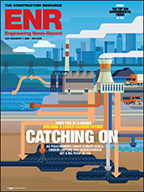Gary M. Wisniewski, CEO of Antea USA Inc., says that while this recession has hit clients harder than any before, those with “consumer brands have an intense need to have a clear message about their overall environmental performance … and it's carrying through the supply chain.”
Cleaning Up on Cleanup
Cleanup of high-profile environmental disasters last year—such as the Deepwater Horizon oil-platform explosion in the Gulf of Mexico and the gas pipeline explosion in California—benefited a number of Top 200 firms, particularly Australia's Cardno Ltd. The firm debuted on the list this year at No. 36 after its 2010 acquisitions of Entrix and ERI, both of which are major remediation contractors to BP. They are also believed to be providing environmental services to ExxonMobil following the leak in June of its Yellowstone River oil pipeline in Wyoming.
Hazardous-waste remediation remains the largest market sector for the Top 200, comprising 21.6% of firms' revenue in 2010. “It's been said for years that this kind of work is going to go away, but every day there are new sites and issues to address or sites that were found not to have been fully remediated the first time,” says Tracy Stenner, vice president at Battelle. “We just received a $75-million contract from the Navy to look at contaminated sites. Work from that job is already coming in.” Top 200 firms reported that revenue from federal clients rose 13.2% last year.
U.S. Defense Dept. “performance-based remediation contracts are bundling more than one installation, and RFPs are larger in size,” says Ernest Enrique, president of TolTest Inc., a new subsidiary of Lakeshore TolTest Corp. This trend will persist in the federal market in 2011, Enrique says. To better manage heightened risks on larger jobs, the parent firm was formed last year when Lakeshore Engineering acquired Toltest in a stock exchange transaction.
The federal market, particularly U.S. Energy Dept. nuclear-waste cleanups, was key to Los Alamos Technical Associates Inc. (LATA), another first-timer on the Top 200 list. Buoyed by considerable federal stimulus funding, the nuclear-waste cleanup sector accounted for $8.8 billion in Top 200 revenue in 2010.
LATA Vice President Eric Coles confirms that major contract wins last year to decontaminate and decommission old DOE uranium-enrichment facilities at its Oak Ridge, Tenn., and Paducah, Ky., sites helped boost its backlog by 340%. With market changes ahead, he expects that backlog level to stabilize this year.
One firm that pushed a growth plan to boost its bonding capacity to over $100 million on environmental projects was NCM, a newly renamed entity made up of remediation and demolition firms Nuprecon, CST and Marcor. Planned in 2005, the merger was shelved when the economy tanked, but negotiations restarted in 2010.
“Collectively, we're offering a turnkey company,” says CEO Subhas “Sage” Khara. “Clients want a large company with strong bonding and surety capacity since there is still a lot of uncertainty with small and mid-sized contractors,” he adds, anticipating more work in industrial and powerplant decommissioning. “We're on track to surpass our budgeted revenue by 30% this year over 2010,” according to Khara.
The environmental group at Lowell, Mass.-based TRC grew 9% in each of the first three quarters of the firm's fiscal 2011, which ended on June 30, says Chris Vincze, company CEO. The group's growth stemmed from remediation, licensing and permitting, cultural-resource consulting and air-quality compliance, Vincze states.






